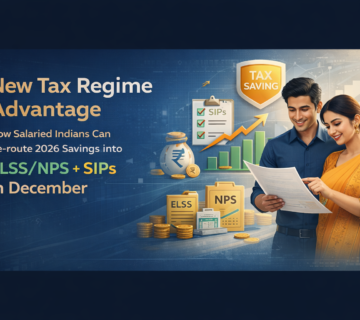 What does it really take to retire with ₹5 crore in your account? As a 35-year-old individual, this question might look a bit unusual. But think about it deeply. This is the time when you should start planning for your future, and especially retirement. If you do so, you will not just gain confidence but also be able to live your later years on your terms.
What does it really take to retire with ₹5 crore in your account? As a 35-year-old individual, this question might look a bit unusual. But think about it deeply. This is the time when you should start planning for your future, and especially retirement. If you do so, you will not just gain confidence but also be able to live your later years on your terms.
So, even if you have a massive salary or think that the stock market will support you, it is time that you think twice. Infact, the top wealth management and Service firm in India, also pushes this idea of planning early and staying safe in the future.
With this being adopted now, many people are looking for the best wealth management services in Gurgaon. These companies not only help in the planning but also suggest to you the timely updates and changes that you must make to ensure your goal is attained.
In this guide, we share the details of how you can reach the goal of a ₹5 crore retirement corpus with ease. With realistic plans and ideas, this will help you shape the future that you wish. So, let us get started here.
Why Start Now?
At 35, retirement feels like a distant goal. There is no doubt in this. But financially, it’s the perfect time to start planning. You’re likely earning steadily, managing your expenses, and still have two to three decades to let your money grow.
This is when compounding becomes your greatest ally. It allows you to turn small amounts of money into great wealth in the future. This is one of the reasons why the top wealth management service providers in Gurgaon suggest an early start.
Here’s why starting now is not just smart, but essential:
1. Time Creates Wealth, Not Just Money
The biggest advantage you have at 35 is time. When you start early, your investments have more years to grow and compound. This means even modest amounts can multiply significantly over the long term.
For example, if you invest ₹25,000 per month at an 11% annual return:
- In 20 years, it will grow to around ₹1.8 crore
- In 25 years, it will reach up to ₹3.6 crore
- In 30 years, it will cross ₹6 crore
The difference comes purely from starting earlier and letting compounding do its work.
2. You Can Start Small and Build Up Gradually
Planning at 35 allows you to begin with what you can afford and increase your investments as your income grows. You don’t need to take big financial risks or chase high returns. Steady contributions, even with small increases each year, can deliver big results over time.
3. Volatility Becomes Less Scary
When you invest with a 25-year horizon, short-term market ups and downs lose their power. You have the time to stay invested, ride through corrections, and let the markets recover. This gives you the emotional confidence to stick to your plan.
4. Tax Benefits Add to Your Wealth
Early retirement planning also comes with tax advantages. Investments like ELSS, NPS, and PPF not only grow your savings but also reduce your tax liability each year, adding more value in the long run.
Many professionals now turn to the best retirement planning company in Gurgaon for guidance, but even the best plan needs time to work. The sooner you start, the smoother your journey will be.
5 Key Choices to Build a ₹5 Crore Retirement Corpus by 60
Retiring with ₹5 crore is not a matter of luck or guessing the market. It comes from making consistent, thoughtful decisions over time. If you’re 35, you still have the most important asset on your side. With a 25-year window, here are five smart choices that can help you reach your retirement target without unnecessary stress or risk.
1. Start a Long-Term SIP in Equity Mutual Funds
This is your growth engine. A monthly SIP in well-rated equity mutual funds can help you stay disciplined, ride market fluctuations smoothly, and benefit from compounding. At an expected annual return of 11 percent, investing ₹35,000 per month can help you reach ₹5 crore in 25 years.
Even if you start lower, say ₹20,000, you can reach your goal by increasing your SIPs annually. The secret is to start now and stay consistent.
2. Use NPS to Add Stability and Tax Efficiency
The National Pension System (NPS) is a smart addition to your plan. It offers exposure to both equity and debt while also reducing your taxable income. Investing ₹50,000 annually gives you benefits beyond the usual 80C deductions.
NPS works best as a long-term supplement to mutual funds, helping you build a second retirement stream that’s both tax-efficient and low-cost.
3. Balance Equity and Debt Wisely
Growth is important, but so is protection. A 70:30 equity-to-debt ratio is ideal when you’re in your mid-thirties. It gives your money the push it needs while reducing the risk of short-term market shocks.
As you get closer to retirement, slowly shift toward a more conservative mix like 60:40 or 50:50. This ensures your accumulated wealth is not lost to unexpected market dips.
4. Increase Your Investments Every Year
Your income is likely to grow each year, so your investments should too. Even a 10 percent annual increase in your SIPs can dramatically improve your corpus. This gradual step-up strategy helps you stay on track without affecting your lifestyle.
5. Review and Rebalance Regularly
Your financial plan is not a set-it-and-forget-it activity. Markets change, goals evolve, and income levels shift. Reviewing your portfolio every year keeps you aligned with your target. Rebalancing helps maintain your equity-debt mix and protects your gains.
Many people rely on a trusted wealth management company in Gurgaon to stay disciplined through these reviews and make course corrections when needed.
What If You Start Late?
Delaying retirement planning often feels harmless in the moment. Life gets busy, income feels tight, and planning for something 20 years away doesn’t feel urgent. But the cost of starting late is rarely visible until it’s too close to correct.
When you postpone retirement planning, here’s what usually follows:
1. Heavier Monthly Investment Burden
With less time to save, you’re forced to contribute a much larger portion of your income every month. What could have been managed with ₹25,000 to ₹35,000 per month over 25 years might now require double or even triple that amount in just 15 years.
2. Greater Family and Financial Responsibilities
As you grow older, so do your obligations, like children’s education, aging parents, home loans, and healthcare costs. These commitments compete for your attention and limit how much you can save for yourself.
3. Lower Risk Capacity
Late starters often cannot afford to ride out market cycles. With less time to recover from dips, they’re forced into safer, lower-return investments that may not deliver the growth required to meet retirement goals.
4. Reduced Lifestyle Flexibility After Retirement
When you start late, you may need to compromise on your retirement lifestyle. Whether it’s travel, healthcare, or hobbies, your spending capacity may be lower than expected, simply because there wasn’t enough time to build a large enough corpus.
5. Increased Stress and Uncertainty
Last-minute planning creates pressure. Without a clear plan, you may find yourself making hasty decisions or relying on short-term fixes that don’t support long-term security.
Starting early is not about investing more. It’s about giving yourself the freedom to invest less, stay calm, and live better, both now and in retirement.
Conclusion
Understanding how your money is growing gives you the confidence to stay on track toward your ₹5 crore retirement goal. If your investments aren’t moving in the right direction, it may be time to reassess your approach and take corrective action.
A mid-year check-in can help you evaluate whether your SIPs, NPS, and asset mix are aligned with your financial goals. This is not just about performance but about clarity, control, and long-term impact. When things feel unclear, reaching out to the best financial planner in India can make a big difference.
The Wealth Escalator by JRG is a smart, simple way to visualise your journey. It shows how today’s actions influence tomorrow’s outcomes and helps you take the next step without stress.
Whether you are adjusting or just getting started, now is the right time. Try the Wealth Escalator today and take charge of your financial future.
FAQs
1. Is ₹5 crore enough for retirement in India?
It depends on your lifestyle and future expenses, but for many individuals, ₹5 crore can support a comfortable retirement if invested wisely. It can provide monthly income, healthcare coverage, and inflation-adjusted growth for 25 to 30 years post-retirement, especially with a smart withdrawal plan.
2. How much should I invest monthly to reach ₹5 crore by age 60?
If you start at 35 with a target of ₹5 crore by 60, you’ll need to invest approximately ₹35,000 per month assuming an 11% annual return. Starting early or increasing your SIP every year can reduce the pressure and improve outcomes.
3. What if I start retirement planning after 40?
You can still reach your goals, but you may need to invest more aggressively or adjust your target. A shorter timeframe means higher monthly contributions and less flexibility with risk. Planning with expert help can ensure realistic and effective solutions.
4. Should I only rely on mutual funds for retirement?
Mutual funds offer strong growth potential, but a balanced plan also includes NPS, fixed income, or pension products. Diversification helps reduce risk and ensures that your retirement income is steady, even in volatile markets.
5. I’m not sure if my current savings plan is enough. What should I do?
It’s normal to feel unsure, especially when goals like ₹5 crore seem far away. The best way to move forward is to review your plan honestly. Check if your monthly investments, asset mix, and timeline are aligned with your retirement target. If not, consider getting guidance from a trusted wealth management company in Gurgaon. They can help you make practical adjustments without adding pressure or confusion.



